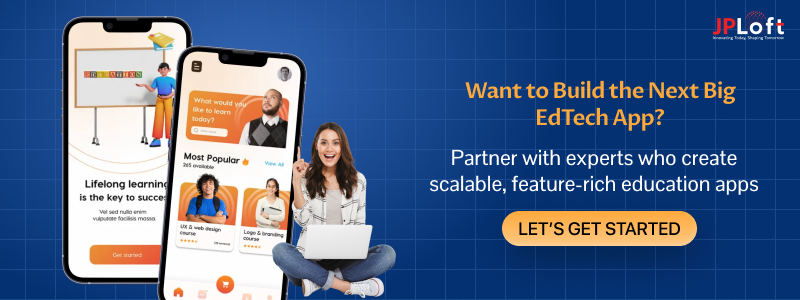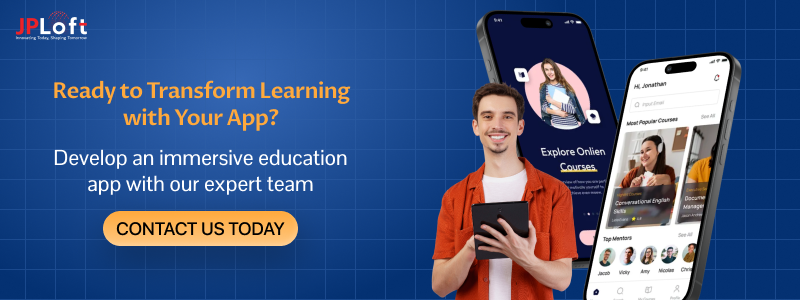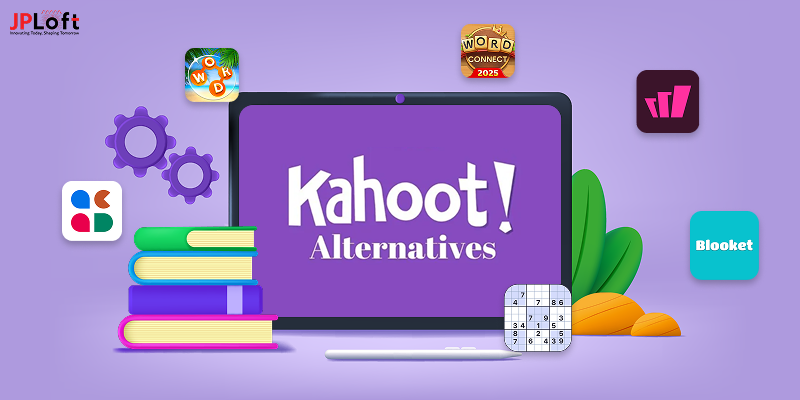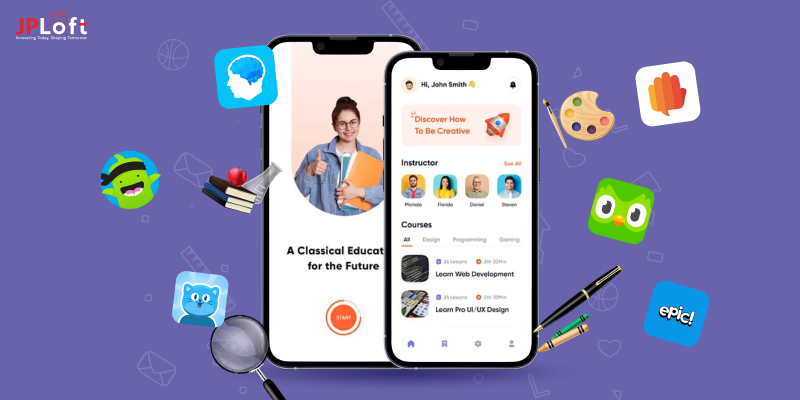Thinking about starting an online education business?
Let’s be honest, learning has officially gone digital. Classrooms are no longer confined to four walls. Now, they fit right into your pocket.
You might skip a cooking app or forget your meditation tracker, but skipping online learning? Not anymore.
Why? Education today is flexible, accessible, and customized for every learner's pace. And that’s exactly where the opportunity lies.
If you’ve ever imagined building something that helps people grow, learn, and level up from anywhere in the world, this is your moment.
In this blog, we’re breaking down everything you need to know to start an online education business from scratch.
From smart strategies and top features to must-have tools and real-world insights, we’ve got you.
It’s not just about apps, it’s about impact. With the right plan, you’re building more than a platform. You’re building futures.
Let’s get started.
Understanding the Online Education Business
So, what exactly is the online education business?
Online education is more than Zoom classes and YouTube tutorials. It’s a full-blown industry, worth billions, and growing faster than most can say “login.”
We’re talking about platforms that teach everything from algebra and app development to yoga, public speaking, or even how to ace interviews.
And the best part?
It’s not just for schools or colleges anymore. Coaches, creators, consultants, and businesses are all jumping in.
One easy thought drives the online education business: people want to learn all the time.
These people will keep coming back if you give them the right information at the right time and in the right manner.
It can be changed. It can grow. And most importantly, it’s deeply personal.
You're not just giving live lessons.
You’re helping people change careers, pass exams, unlock hobbies, or build skills they’ve been chasing for years. And that kind of value? It's worth a lot.
The opportunity is massive, whether you are planning live classes, previously recorded video modules, or engaging course bundles. The only question is: how will you stand out?
Know what the market is. Deliver the value. And boom, you’re not just running a business. You are making futures.
Key Benefits of Investing in an Online Education Business
Let’s talk about the benefits of education apps. If you’re investing time, money, and strategy, you need to know what you’re getting out of it, right?
So, why invest in an online education app?
A] Massive Market
Demand for education never goes out of style. Whether it's upskilling for a new job, picking up a hobby, or preparing for an exam, people are constantly looking to learn.
An online education app gives you access to an always-growing, always-global audience that's hungry for knowledge.
B] Global Reach, Zero Borders
Say goodbye to local limitations. With an education app, you can reach learners across the world, from Mumbai to Melbourne to Madrid, instantly.
No classroom size limits, no time zone constraints. Your content is available 24/7, anywhere your users are.
C] Recurring Revenue
Unlike one-time course sales, education apps let you create ongoing income.
Through subscriptions, in-app sales, certification fees, and course bundles, you're building a reliable revenue stream that scales over time.
D] Scalable and Customizable
As your content library grows or your community expands, your app can change too.
Add more courses, promote different languages, or offer premium membership tiers. A well-structured education app grows with your goals, not against them.
E] Personalized Learning Experience
Modern learners want more than basic videos. They crave interaction and personal growth.
With features like quizzes, badges, learning streaks, and AI-powered recommendations, your app becomes more than a platform; it becomes a specialized guide.
F] Brand Credibility and Loyalty
A simple, beautifully designed education app builds confidence. When people enjoy a smooth learning experience, they trust your company more.
You're no longer just an educator; you're a digital institution that people come to and suggest.
G] Future-Proof Your Business
The world is digital, and education is no exception. Whether you're an individual tutor, an entrepreneur, or a big institute, going online ensures you stay current.
A mobile app sets you up to thrive in today's tech-driven education environment.
H] Data-Driven Decisions
Track real-time user behavior, course performance, and interest rates.
With detailed data, you can make smarter changes, refine content, and continually improve your app for better results and higher ROI.
The Benefits of Education Apps go way beyond convenience. It’s about influence, impact, growth, and profitability.
Important Considerations Before Launching an Education Business
So, you’re excited to launch your education app?
That enthusiasm is great. But before you dive headfirst into development, let’s slow it down just a little.
Because trust me, the prep work you do now will save you from some major headaches (and unexpected costs) later.
Let’s break down the non-negotiables you need to have sorted before your dream app goes live.
1. Define Your Niche
Education is a vast ocean. You don’t want to be just another drop.
Are you focusing on K-12 learning? Test prep for SATs, UPSC, or IELTS?
Corporate skill-building? Language learning? Or maybe niche coaching like design, trading, or parenting?
Pick a niche that not only has demand but also aligns with your expertise and vision. Specificity sells.
2. Target Audience Analysis
Who exactly are you building for?
Teens cramming for exams? Professionals upskilling on the go? Parents hunting for kids’ learning resources?
You need to understand their pain points, preferences, tech habits, and attention span. Build for them, not for what you “think” they need.
3. Competitive Research
Look around. What other apps are doing well? Where are they falling short?
Identify direct and indirect competitors, study their features, pricing models, and user reviews, then aim to offer something better, smoother, or smarter.
It’s not about reinventing the wheel; it’s about making your ride smoother.
4. Licensing and Content Rights
This part might not feel fiery, but it’s very important.
Whether using third-party material, tutors, institutions, or original content, ensure your licensing is solid. Nobody wants copyright claims post-launch.
And if you’re planning to allow user-generated content, have clear terms and guidelines in place.
5. Tech Readiness
An amazing idea needs a strong tech backbone.
What platform are you launching on? iOS, Android, Web, or all of them? Do you need live class integration, video hosting, gamification, or AI features?
Step-by-Step Guide to Building Your Online Education Platform
Thinking about launching your online education platform? Then it’s time to stop thinking and start building.
This isn’t the future, it’s the now. With education getting mobile, global, and personalized, your app could be the next big thing in digital learning.
But where do you begin? Right here.
Follow this step-by-step guide to build an online education app, and you'll create a platform that is scalable, powerful, and profitable, just like launching a successful edtech startup.
Let's break it down.
Step 1: Validate Your Idea
You wouldn’t launch a new product without testing the waters first, right? The same logic applies when building your online education app.
Before you even think about writing code, pause and ask yourself a few game-changing questions:
-
Is there actual demand for your chosen subject or niche?
-
What real-world problem are you solving for learners?
-
Who else is already doing it, and can you do it better?
This is your validation phase, and skipping it is a rookie move. You don’t want to pour resources into something the market doesn’t need.
Run surveys. Build a quick landing page. Launch a mini course. Talk to real users.
This early research helps you avoid blind spots, reduce risks, and refine your strategy before investing big.
Smart founders validate first. Every. Single. Time.
Step 2: Define Your Target Audience and Features
Who's your education app really for? High schoolers ready for competitive exams? Are busy professionals improving their skills? Maybe parents are exploring side hustles or new hobbies?
Knowing your target audience shapes everything, from the tone of your content to the design of your app. You describe your people first, then build especially for them.
Once you've nailed your audience, map out the must-have features in an education app.
Think user-friendly login, customizable accounts, progress tracks, certifications, video lessons, and a sprinkle of games to keep learning fun and addictive.
These aren't just features of the education app; they're the secret sauce that makes casual users into loyal learners who keep coming back for more.
Step 3: Design UX/UI That Hooks Users
Here's where creativity meets planning. Your education app design isn't just about looking good; it's about feeling right.
Starting with a solid mobile app prototype and thoughtful mobile app wireframing sets the foundation for a clean design, flexible screens, and easy browsing; the basis of a great user experience.
If you want learners to stay, explore, and come again and again, your UX should feel normal. It should guide users easily, not annoy them with clunky interfaces or confusing flows.
Design your app to be a place users enjoy coming back to. When learning feels smooth and rewarding, their engagement naturally grows.
That smooth, enjoyable experience is exactly what keeps your education app successful in the long run.
Step 4: Choose the Right Technology Stack
Let’s talk about mobile app tech stack, because what’s under the hood makes or breaks your education app.
Whether you’re building a native mobile app, a hybrid solution, or a full-scale web platform, your tech stack directly impacts speed, scalability, and user experience.
Here’s a quick breakdown:
-
Backend: Node.js, Python, or PHP
-
Frontend: React, Flutter, or Swift
-
Database: MongoDB, Firebase, or MySQL
-
Video Integration: Agora, Twilio, or Zoom SDK
Choosing the right stack isn’t just about performance; it’s also about future-proofing your app.
From fast opening times to crystal-clear video streaming, every detail helps when delivering a smooth learning experience.
Not sure where to start?
Don’t stress. Professional mobile app development services can help you build scalable, efficient education systems tailored to your goals.
Step 5: Develop the Minimum Viable Product (MVP)
Start small, but start smart.
Your Minimum Viable Product (MVP) should focus on the essential features that directly solve your learners' core problems.
Think of it as a soft launch: a stripped-down version of your full education app that lets you test the waters without investing.
Your MVP gets vital early feedback from real users, helping you identify what works, what needs improvement, and what can wait for future changes.
By launching an MVP, you avoid going through your entire budget ahead, lower risks, and build a learning platform that truly meets your users' needs.
It's the best way to kickstart your education app journey and set the stage for long-term success.
Step 6: QA Testing
Before your app goes live, thorough mobile app testing is a must.
This includes functional testing to ensure every feature works as expected, compatibility checks across devices and operating systems, fixing bugs that could ruin user experience, improving the UI for smooth movement, and load testing to see how your app performs under pressure.
It also involves rigorous checks for mobile app security to protect user data and prevent vulnerabilities.
Even small problems can tank your app’s image on day one, so don’t take shortcuts.
Thorough testing helps catch issues early, ensuring you launch a flawless product that users can rely on and genuinely enjoy.
If you’re not confident handling it all yourself, consider working with pros who specialize in mobile app testing and security to ensure your app launches smoothly and stands out for all the right reasons.
Step 7: Launch
Raise a toast; your education app is ready to go live! “
But launching isn't just about hitting "publish."
To make a real splash, you need a well-planned rollout strategy that gets learners talking and downloading from day one.
Start by building hype with targeted email campaigns, influencer partnerships in the education space, and smart content marketing tailored to your audience.
Consider launching a waitlist to build anticipation and secure eager early adopters ready to dive in.
Think like you're launching a major app; you want buzz, excitement, and authentic user reviews that build credibility.
And don't forget the crucial final step: publish your app on the Play Store or submit your app to the App Store so you can reach learners where they spend most of their time.
A smart, strategic launch lays the foundation for long-term success. Plan carefully, engage your audience early, and watch your education platform take off!
Step 8: Ongoing Support & Maintenance
The real work begins after your education app launches; it’s time for app maintenance services.
It’s time for continuous mobile app maintenance, fixing bugs, updating course content, adding new features, and ensuring compatibility with the latest operating systems.
Without this ongoing effort, even the most innovative education apps can lose users and fall behind.
Providing excellent support to your learners is just as crucial. Fast responses and helpful service keep your user community engaged and motivated to keep learning.
Running a successful education platform means embracing constant improvement. The best apps aren’t built once and forgotten; they evolve continuously.
Prioritize mobile app maintenance, and you’ll keep your learners loyal, your app competitive, and your education business thriving in a rapidly changing digital landscape.
Step 9: Scale and Monetize
You've validated, launched, and stabilized your education app; now it’s time to scale.
Explore proven educational app business models like subscription plans, course bundles, freemium with upsells, certification payments, and B2B licensing for schools or enterprises.
These models open up multiple revenue streams while increasing long-term user value.
Keep a close eye on user behavior and in-app activity. Double down on features that drive engagement and streamline what’s not performing.
With the right strategy, growth becomes a matter of smart planning rather than risky guessing.
And don’t forget, effective education app monetization doesn’t just generate revenue; it also delivers powerful analytics that help you iterate fast, refine your offering, and stay one step ahead in the competitive EdTech space.
Top Online Education Apps to Take Inspiration From
If you're serious about building a standout education platform, studying the top players in the space isn't just smart; it's essential.
These apps have cracked the code on engagement, UX, and scalability.
So if you're ready to build your education app, here are the online education giants you should take inspiration from.
► Coursera
Coursera revolutionized online learning by collaborating with top universities and global institutions.
Its strength lies in delivering high-quality, accredited courses that learners trust.
Leveraging advances in AI in education, Coursera enhances personalized learning experiences through adaptive content and smart recommendations.
With structured programs, self-paced options, and globally recognized certifications, Coursera strikes the perfect balance between academic depth and learner flexibility.
It's a strong benchmark for any education app focused on scale, trust, and monetization.
► Duolingo
Duolingo turned learning into a game, and that changed everything. With points, streaks, and level-ups, this app makes language learning feel fun and addictive.
Its gamified approach not only improves engagement but also boosts retention like few others in the space.
If you're developing an education app like Duolingo, it is proof that a little playfulness in UX can go a long way in driving growth and loyalty.
► Udemy
Udemy thrives as a massive marketplace for online courses, giving instructors the tools to create, publish, and profit from their content.
Its success lies in scale and accessibility: from coding to cooking, users can find courses on almost anything.
The platform uses a freemium model paired with smart promotions to attract and convert learners.
For aspiring edtech founders, Udemy offers valuable insights into user-generated content, marketplace management, and monetization strategy.
► Khan Academy
Khan Academy’s strength lies in its mission-driven approach: free, world-class education for anyone, anywhere.
The app stands out for its intuitive design and expansive library of video lessons across subjects.
It’s a powerful example of how meaningful content and a clear purpose can build deep user trust and long-term loyalty.
If your goal is to deliver impact-driven education, Khan Academy’s model offers valuable inspiration.
Whether it’s Coursera’s academic credibility, Duolingo’s gamified learning, Udemy’s creator-first marketplace, or Khan Academy’s simplicity, these platforms show what it takes to thrive in the online education space.
If you’re aiming to build a game-changing education app, studying these giants is step one.
Their strategies for engagement, monetization, and user experience design lay the foundation for success.
Ready to turn your edtech idea into a real-world success story? Let’s get started.
Cost to Start an Online Education App
When you're planning to build an online education platform, knowing your numbers isn't optional; it's essential.
Budgeting wisely from the beginning can mean the difference between a successful launch and frustrating delays.
Just like any digital product, the Mobile App Development Cost for an education app varies based on features, design complexity, tech stack, and scalability needs.
Here’s a stage-by-stage breakdown to help you plan better:
|
Stage |
Description |
Estimated Budget Allocation |
|
Planning & Research |
Conduct market research, validate your niche, and outline key features. This stage shapes your entire roadmap. |
5–10% of the total budget |
|
UI/UX Design |
Craft intuitive wireframes and engaging interfaces to keep learners motivated and focused. |
15–20% |
|
Development |
Code core features like video modules, progress tracking, quizzes, and push notifications. Choose between native or cross-platform solutions. |
40–50% |
|
Backend Infrastructure |
Set up cloud hosting, API integrations, databases, and secure user authentication. Performance and scale matter. |
15–20% |
|
Testing & Launch |
Run QA checks, bug testing, and ensure compatibility across devices and OS versions before going live. |
10–15% |
|
Maintenance & Support |
Regular updates, feature rollouts, and bug fixes to keep your app optimized post-launch. |
15–20% annually (of dev cost) |
Planning for these phases helps avoid surprise expenses and keeps your online education business running smoothly from day one.
A well-structured budget gives your app room to grow without breaking the bank. Understanding the cost to build an educational app helps you align your goals with your financial strategy.
Whether you're adding AI tutors, interactive video lessons, or live classrooms, your choices in each stage directly impact cost and quality.
Ready to turn your vision into a high-performing education platform? Start with strategy. Build with intent. Grow with confidence.
Key Challenges in Building a Successful Education Business
Building an online education platform sounds exciting, and it is, but let's not sugarcoat it: there are some real challenges along the way.
If you're serious about creating a standout learning experience, you need to be prepared for the bumps that come with the build.
Here's what to expect and how to tackle it like a pro:
1. Ensuring Content Quality
If your content isn’t valuable, engaging, and accurate, users won't stick around. You're not just uploading videos; you're shaping minds.
From course structure and instructor expertise to the clarity of explanations and visuals, content is king.
The challenge? Maintaining high standards consistently across subjects and contributors.
These are some of the biggest education app development challenges that creators and developers face when building a successful learning platform in 2025.
Pro tip: Work with subject matter experts and build a content review process early on.
2. User Engagement and Retention
Getting users to download your app is one thing. Getting them to come back, again and again?
That’s the real game. Learners today expect interactive, gamified, and personalized experiences.
If your app feels like a digital textbook, users will bounce. Engagement features like quizzes, badges, progress trackers, and peer discussions are a must.
3. Live Streaming Issues
Live sessions offer real-time connection, but they're tricky. Bandwidth problems, latency, and poor video quality can ruin the learning experience fast.
To handle this, you need a reliable live streaming solution, strong backend support, and a plan for recording sessions in case users miss them.
4. Data Privacy & Security
In education, you're dealing with sensitive data: names, emails, performance records, even payment info. One security slip, and trust goes out the window.
You’ll need strong encryption, GDPR compliance, and secure cloud storage. Make data privacy a priority from day one, not an afterthought.
5. Accessibility Across Devices
Your users could be on Android, iOS, tablets, or desktops. Making your app function seamlessly across all devices and screen sizes is a challenge, but a non-negotiable one.
Cross-platform development, responsive design, and thorough device testing help ensure everyone gets the same smooth experience.
Every app faces challenges, but these hurdles are manageable with the right strategy, tools, and development support.
Whether it’s content quality or live-stream stability, tackling each obstacle with intent will set your education platform up for long-term success.
Monetization Models for an Online Education Business
Let's be real: while your goal might be to educate and empower, your app still needs to generate consistent revenue to stay sustainable.
Luckily, education apps offer several flexible and scalable ways to monetize without compromising on value.
Here are the top mobile app monetization models you can explore:
► Freemium Model
This is one of the most popular models for educational platforms.
The app is free to use, but certain features or content are locked behind a paywall. Think of it like giving users a taste before they commit.
Free access builds trust, while premium upgrades like exclusive courses, ad-free learning, or advanced analytics bring in steady revenue. Duolingo and Khan Academy do this brilliantly.
► Subscription Plans
Recurring revenue? Yes, please.
With a subscription-based model, users pay weekly, monthly, or yearly to access the full suite of content and features.
This approach works well if your app offers regularly updated content or new courses.
You can even offer tiered pricing: basic access for casual learners and premium plans for power users. This model brings predictable cash flow and boosts long-term retention.
► In-App Purchases
Think downloadable PDFs, bonus lessons, certification exams, or personalized tutoring sessions.
In-app purchases let users customize their learning experience without committing to a full subscription.
It’s flexible, user-driven, and can easily supplement your freemium or subscription model.
► Affiliate or Partner Programs
This is where your education app becomes a gateway to bigger opportunities.
Partner with e-learning platforms, book publishers, tech brands, or educational tools.
Promote their services in-app and earn a commission for every referral or sale. It’s a smart way to generate passive income while offering users valuable resources.
► Paid Certifications
Knowledge is great, but proof of it? Even better.
Offer official certifications at the end of certain courses or modules.
Users appreciate tangible rewards for their effort, especially when they enhance their career prospects or academic profile.
Charging a small fee for verified certificates can become a major revenue stream, especially if your app builds authority and trust.
The right mix of these models depends on your target audience and content strategy. Blend them smartly, and you’ll have a learning platform that not only educates but thrives.
Trends in Online Education Apps (2025 & Beyond)
The education app landscape is evolving faster than ever, and 2025 is already shaping up to be a game-changer.
If you're planning to build or upgrade your app, you need to be ahead of the curve.
These key education app trends aren't just buzzwords; they're reshaping how we teach, learn, and interact with digital education platforms.
► Artificial Intelligence (AI) Personalization
AI allows education apps to become more than just static content delivery systems.
With the help of advanced AI development services, apps can now deliver real-time customization by analyzing student performance, learning pace, and behavior.
Whether it's recommending specific modules, reshuffling lessons, or offering targeted practice sessions, AI brings an intelligent, adaptive touch to every learner’s journey, boosting engagement and outcomes like never before.
► Gamified Learning
Why just learn when you can play while doing it?
Gamification (think points, levels, badges, and rewards) turns dry lessons into addictive experiences. It increases motivation and makes users want to keep coming back.
If Duolingo taught us anything, it’s that gamified learning works brilliantly.
► AR/VR for Immersive Education
Welcome to the era of hands-on digital learning.
Augmented reality (AR) and virtual reality (VR) bring abstract concepts to life, whether it’s dissecting a 3D frog or exploring ancient cities in a virtual time machine.
These immersive tools deepen understanding and are becoming more accessible with each passing year.
Many education providers are now investing in professional AR/VR development services to create engaging, interactive learning experiences that truly captivate students.
► Voice-Enabled Learning
With smart assistants like Siri, Alexa, and Google Voice everywhere, voice-enabled learning is making a big impact.
It allows for hands-free interaction, pronunciation training, and easier accessibility for users with disabilities or screen fatigue.
Expect to see more apps integrating voice commands and responses in 2025.
► Machine Learning (ML) Adaptation
ML goes beyond surface-level personalization. It continuously learns from how users interact with the content, identifying patterns to optimize future learning paths.
For example, if a learner consistently struggles with math at night but excels in the morning, ML can adjust the schedule accordingly.
This self-improving loop boosts both performance and satisfaction.
Many companies now rely on expert ML development services to build these intelligent, adaptive learning systems that evolve with each user’s needs.
► Microlearning Modules
Bite-sized is big.
Today's learners prefer short, focused modules they can consume on the go.
Whether it's a 5-minute video, a flashcard quiz, or a quick concept breakdown, microlearning boosts retention while respecting users' time.
It’s perfect for busy professionals, students, and anyone who wants to learn on their terms.
► Natural Language Processing (NLP) for Smarter Interaction
NLP helps make communication between learners and the app feel more human.
From voice-activated commands to AI-powered chat support and grammar correction, NLP enables smarter feedback and interactive learning.
It also powers speech-to-text features and sentiment analysis, helping students feel understood and supported in real time.
Many education platforms partner with expert NLP Development Services to build these advanced, responsive features that transform how users engage with learning content.
Staying aligned with these trends is the smartest way to future-proof your online education platform and make sure you're always delivering what learners want.
How JPLoft Can Help You Build a Successful EdTech App
Looking for the best education app development company to bring your vision to life?
JPLoft specializes in creating custom eLearning solutions tailored to your goals and audience.
Whether you’re building an app for K-12 students, professional upskilling, or niche training, we deliver cutting-edge features with precision.
From interactive video lessons and live classrooms to AI-powered learning paths and gamified quizzes, our experts bring your vision to life.
Let us help you launch an education app that's smooth, scalable, and seriously engaging, turning your platform into every learner's favorite go-to for knowledge.
Conclusion
Starting an online education business is more than just launching an app. It’s about creating a platform that inspires, educates, and grows with its users.
From validating your idea and choosing the right features to mastering mobile app monetization and staying ahead of trends, every step shapes your success.
With the right strategy, tech stack, and a trusted education app development company by your side, your vision can turn into a high-performing platform that learners love.
Whether you're targeting students, professionals, or lifelong learners, the opportunity in EdTech is massive and growing.
Now is the perfect time to turn your educational dream into a digital reality. Ready to build something powerful and impactful? Let’s make it happen.
FAQs
MVPs can launch in 3 to 6 months, but fully featured education apps with interactive content and advanced features may take 6 to 12 months, depending on complexity.
User experience and learner engagement. Focus on intuitive design, smooth content delivery, and features that keep learners coming back.
Absolutely! Niche subjects, innovative teaching methods, and personalized learning experiences create plenty of opportunities.
Validate your idea, identify your target learners, tures, develop an MVP, test thoroughly, and prepare a solid launch and growth strategy.
Content quality, learner retention, technical scalability, and data security are major hurdles. A clear vision and a skilled team are essential to succeed.














Share this blog